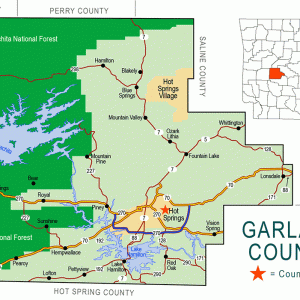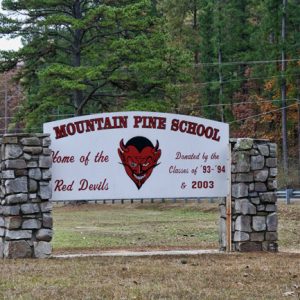calsfoundation@cals.org
Mountain Pine (Garland County)
| Latitude and Longitude: | 34°34’19″N 093°10’24″W |
| Elevation: | 472 feet |
| Area: | 1.66 square miles (2020 Census) |
| Population: | 585 (2020 Census) |
| Incorporation Date: | May 23, 1966 |
Historical Population as per the U.S. Census:
|
1810 |
1820 |
1830 |
1840 |
1850 |
1860 |
1870 |
1880 |
1890 |
1900 |
|
– |
– |
– |
– |
– |
– |
– |
– |
– |
– |
|
1910 |
1920 |
1930 |
1940 |
1950 |
1960 |
1970 |
1980 |
1990 |
2000 |
|
– |
– |
– |
– |
1,155 |
1,279 |
1,127 |
1,068 |
866 |
772 |
|
2010 |
2020 |
|
|
|
|
|
|
|
|
|
770 |
585 |
|
|
|
|
|
|
|
|
Mountain Pine was the second-largest community in Garland County, behind Hot Springs, from the 1930s through the late 1970s. During that time, it was a typical company mill town of the forested South. Established in the late 1920s by Dierks Lumber and Coal Company (later Dierks Forests, Inc.), Mountain Pine remains as the most visible reminder of the Dierks company’s legacy in Garland County.
Dierks Brothers Company was founded in the 1880s by Hans, Herman, Peter, and Henry Dierks, sons of German immigrant Peter Henry Dierks. In 1895, the company became Dierks Lumber and Coal Company, which owned and operated numerous lumber yards in Iowa and Nebraska. By 1900, the Dierks brothers owned twenty-four lumber yards in the Midwest. In that year, the company made its first purchase in Arkansas, acquiring a mill in De Queen (Sevier County). After this time, the Dierks Lumber and Coal Company expanded, particularly in Arkansas and Oklahoma. Between 1900 and 1930, the company came to operate more than twenty retail lumber yards, built and operated six lumber mills, constructed railroads, acquired at least twelve lumber manufacturing or timber companies, purchased over 1,250,000 acres of land, and implemented some of the first forestry conservation policies in the South. The Dierks family established a lumber dynasty that made the Dierks name a household word in the region throughout the twentieth century.
Dierks first purchased land and timber rights in Garland County in 1922 as the company began to buy up large swaths of timber in the heart of the Ouachita Mountains as a basis for two new sawmills, one in Arkansas and the other in Oklahoma. Each mill would have a logging railroad and mill town. Arkansas Power and Light (AP&L), which had plans for a dam on the Ouachita River at Blakely Mountain, approximately one mile northwest of the community of Hawes (Garland County), offered Dierks an appealing opportunity: the dam’s entire reservoir area would need to be completely stripped of trees. Company president Herman Dierks announced in November 1926 that the company had chosen a site for the new Arkansas facility “close to the reported site of the third hydro-electric dam on the Ouachita River.” Dierks’s purchase of strategically located properties provided the company not only with prime timber but also easy access to the new mill. This way, the company gained access to thousands of acres of pine in Blakely Dam’s reservoir area, including some of the finest timber in the Ouachita Mountains. By the time the company’s new facility at Mountain Pine opened, Dierks controlled the timber rights for or owned thousands of acres in the heart of the reservoir area.
Company officials announced that the new facility and town at Mountain Pine would include a mill “of steel construction,” and that “the houses that we will build for our people will be modern and comfortable, and no less than 150 such homes will be included in the first part of the program….We will give them a modern church and school building. Then, too, they will have their own moving picture theatre for there must be a diversion, too. It will not be all work and no play.”
Work began in January 1927. Men began clearing ground for the new mill and laid out a town site for workers’ homes. The mill’s projected cost escalated to over $500,000, according to the local newspaper. The new Dierks mill at Mountain Pine became fully operational in 1928 and had an initial daily capacity of 165,000 board feet. The mill facility covered an area of over fifty acres and initially employed about 350, with another 125 involved in woods or logging work.
The company town of Mountain Pine became a typical mill community of the era. All houses were owned by the company and rented to employees for between five and twenty dollars per month. A company store, often referred to as “the commissary,” provided food and supplies for the town’s residents. A company doctor provided medical services for employees and their families. As promised, other amenities included a school, church, and theater.
Today, many milling communities no longer exist, but Mountain Pine has survived through the years, persisting even after the sale of the entire Dierks holdings—including the Mountain Pine facility—to the Weyerhaeuser Company of Tacoma, Washington, in 1969. Weyerhaeuser continued to operate the mill, but the character of the town changed as the company became less involved in the personal lives of the employees; for example, the company offered employees the opportunity to purchase their homes when it sold most of its town assets except for the mill. The commissary, too, came under private ownership. A new school was constructed a few years later, outside of the boundaries of the original company town.
Economic downturns coupled with changes in the timber industry resulted in the Mountain Pine mill’s gradual operational slowdown and eventual closure in 2006. At the time, more than 300 were employed there. The following year, Weyerhaeuser officials deeded several buildings and more than eighteen acres of land to the City of Mountain Pine, as a “gesture of goodwill to the community where Weyerhaeuser operated for many years.” The mill facility was finally dismantled, not only changing the area’s physical landscape, but also ending the Dierks-Weyerhaeuser eight-decade tenure in the town. While surpassed by Hot Springs Village (Garland and Saline counties) in the late 1970s as Garland County’s second-largest population center, the town of Mountain Pine continues to exist today, even without its mill operation. In January 2017, the city council voted to disband the community’s one-person police force and to contract out patrol coverage from the county sheriff’s department.
For additional information:
Dierks, F. M. “Don,” Jr. The Legacy of Peter Henry Dierks, 1824–1872. Tacoma, WA: Mercury Press, 1972.
Dierks Lumber and Coal Company Records. Riley-Hickingbotham Library Archives and Special Collections. Ouachita Baptist University, Arkadelphia, Arkansas.
Richter, Wendy. “The Birth of a Company Town,” The Record 42 (2001): 1–27.
Sensel, Joni. Traditions Through the Trees: Weyerhaeuser’s First 100 Years. Seattle, WA: Documentary Book Publishers, 1999.
Smith, Kenneth L. Sawmill: The Story of Cutting the Last Great Virgin Forest East of the Rockies. Fayetteville: University of Arkansas Press, 1986.
Wendy Richter
Ouachita Baptist University
 Garland County Map
Garland County Map  Mountain Pine School
Mountain Pine School 



Comments
No comments on this entry yet.